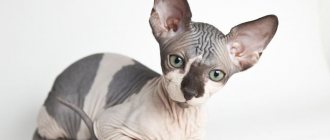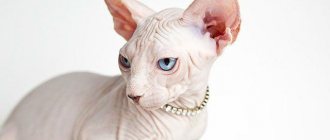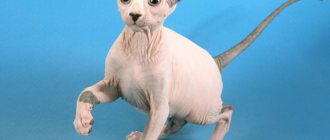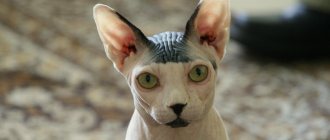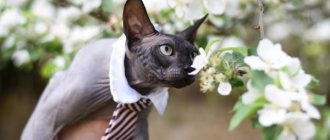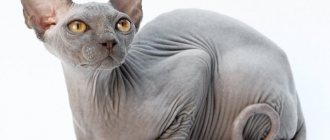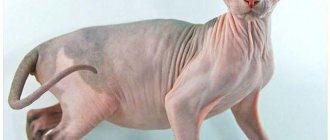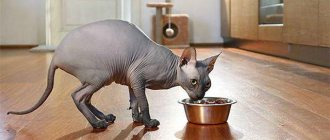History of the Canadian Sphynxes
The history of the breed began in 1966, when a hairless kitten named Prune was born in the Canadian city of Toronto. After some time, the baby and his mother were acquired by the breeder Jania Bava, who ran a nursery of Siamese cats: she and her son Ridyad decided to breed a new breed. Later the Tenhove couple joined the work.
When Prune grew up, he was mated with his mother. Their offspring included both regular and hairless kittens. In the hope of strengthening the trait, breeders began to breed Prun with his daughters and granddaughters, but things went slowly: there was too little breeding material, and hairless kittens often died. In 1971, the CFA revoked the provisional status granted to the breed the previous year. The breeders curtailed their work and sold some of the animals.
In 1973, David Mair from San Francisco bought a cat named Epidermis from them. The man became interested in hairless cats and did a lot to popularize them. In addition to Epidermis, he acquired another bald male and a female. None of his pets left offspring. Two more animals - a male and a female - were purchased from the Bava couple by the Mewsi-Kal nursery, owned by Sandy Kaiser. This couple gave birth to kittens - a boy, Starsky, and a girl, Johnny. In 1978 they were sent to the Netherlands to breeder Hugo Hernandez. However, a problem arose: the litter born from a single mating of animals died because the mother abandoned it.
In 1978, in Toronto, a woman named Shirley Smith rescued two stray kittens abandoned by their mother: a hairless boy named Bambi and a long-haired girl.
Bambi was injured, including a bloody eye and damaged testicles, which required him to be castrated. Nevertheless, the baby was released, and he happily lived for another 19 years in the Aztec nursery. The touching story of this rescue contributed greatly to the popularization of the breed.
A year later, Bambi's mother brought another litter, which included two hairless girls. This cat is considered one of Prune’s undocumented descendants, especially since it happened relatively close to the first cattery.
The girls were sent to Holland to Hugo Hernandez and entered into a breeding program under the names Punky and Paloma. However, Starsky showed no interest in any of them, and in 1981 he was neutered and declared unfit for breeding. Only after this it was discovered that Paloma, who by that time had been given to breeder Nanny Nathan, was pregnant by him. Unfortunately, the cat did not bear offspring.
Since there were no more males available, Punky was bred to a Devon Rex named Kerer van Jetrophin. After this, a litter of hairless kittens was finally born safely. Subsequently, Devon Rex were regularly used to replenish the gene pool.
The “Canadians” inherited their characteristic ears from the Devon Rex.
In parallel, a second line of sphinxes arose. In 1975, in Minnesota, an American Shorthair cat owned by the Persons gave birth to several hairless kittens in different litters. According to different versions, she could be a descendant of Prune or receive the baldness gene due to a random mutation.
In 1981, two hairless cats that belonged to the Persons were purchased by the Stardust cattery. His owner Kim Muesk initially tried to use American Shorthair cats for breeding, but failed. Then Solveig Pfluedger - chair of the genetics department at TICA - advised her to use Devon Rex cats, and the offspring were successful.
In 1985, TICA recognized the breed. A year later, the cat Lady Godiva, born in the Britanya cattery, received the title Supreme Grand Champion. The CFA recognized the breed in 1998 and created a Champion class for it in 2002.
Currently, hairless kittens sometimes continue to be born due to mutations in cats of various breeds. Nurseries are trying to purchase them for a fresh infusion of blood. At the moment, the breed is recognized by all international felinological organizations.
Mr. Cat recommends: the most characteristic breeds with tabby color
There are a great variety of tabby cats, ranging from the most common outbred pets or street (yard) cats. The elite cats bred by breeders in nurseries include, for example, the following tabby-colored cats:
- Australian Mysts;
- Arabian Mau;
- Bengal;
- British Shorthair;
- Egyptian Mau;
- Leohouses;
- Maine Coons;
- Oriental;
- Ocicats;
- Pixie Bobs;
- Savannah;
- Safari;
- Serengeti;
- Siberian;
- Sokoke;
- Toygers;
- Ceylonese;
- Chinese Li-Hua;
- Highlanders;
- Scottish Fold and Straight.
Fold
Straight
The only breed in which the type of color is present even in the name is the Asian Tabby.
Appearance of Canadians
The modern appearance of the Sphynx was largely formed due to regular crossings with the Devon Rex. The final breed standard from the CFA assumes the following appearance.
Head
The head is shaped like a modified wedge. Its length is slightly greater than its width, the skull is slightly rounded, and there is a flat area in front of the ears. The transition line from the cheekbones to the muzzle is clearly visible. The nose is straight, with a hollow where it meets the forehead. Cheekbones are pronounced. The whisker pads are convex, together with the cheekbones they give the muzzle a somewhat square outline. The chin is strong.
The ears are large, erect, wide at the base. The eyes are wide in the middle and tapering towards the edges, slightly slanted. Can be any color.
The neck is of medium length, strong, slightly arched. In adult cats, pronounced muscles are allowed.
Torso
The body is of medium length, muscular, and seems very heavy. The average weight of cats can range from 3.5 to 6 kg, cats - from 2.5 to 4 kg. Height at withers - 15–25 cm.
The chest is wide, the belly is convex and round. The croup is muscular. The tail is long, tapering towards the end.
The hind legs are longer than the front ones. Limbs are strong, proportional to the body. The feet are oval, with long toes and thick pads.
A convex belly is a characteristic feature of the breed
Leather and wool
Short soft hairs are allowed on the paws, tail, scrotum and outer ears. The hair on the bridge of the nose should be normal. The rest of the body may be completely bald or covered with fine down no more than 2 mm long. The vibrissae are short and broken or absent completely.
The skin is thick, hot, and feels like suede. It gathers into folds around the muzzle, between the ears and on the shoulders. The more there are, the better, as long as it does not interfere with the animal.
Color
For Canadian Sphynxes, any colors are allowed, except those expressed due to the zonation of hair color, for example, chinchilla. There are several common types.
Solid
The skin is evenly colored. The following shades are possible:
- black: slate gray leather,
- black nose,
- Paw pads are black or dark brown.
- bleached black,
- All shades are possible - from bitter to milky;
- cold silver skin with a pinkish tint,
- pink skin of any degree of saturation up to almost white,
- white skin,
Solid color is quite common among sphinxes.
Tabby
Tabby is a striped or spotted striped breed. The neck, dewlap, belly and inner sides of the legs are lighter than the main background, with a slight yellowness. The color of the nose, paw pads, and markings on the lips and chin depends on the color. The markings on the skin are usually the same color as the main background, but a more saturated shade.
Tabby color means lighter underparts
Tortoiseshell
In this case, the animal's skin is covered with large, irregularly shaped spots. The following color options are possible:
- black with red spots;
- cream with blue;
- red-brown with red or cream spots;
- lilac with cream.
Tortoiseshell color is allowed only for females. In males, it indicates a genetic mutation and infertility.
Tortoiseshell color is allowed only for cats
Color point
Color point is a Siamese color: there are dark markings on the face, tail and paws that contrast with the lighter background. The following options exist:
- cream point. The main background is white or light cream, the points are cream;
- seal point. The body is light, the points are dark brown. An adult animal darkens completely;
- chocolate point. The adult has a general background of golden brown. Blue eyes;
- tabby point. The points are striped. The color may have subspecies depending on the color of the stripes.
Initially, kittens of this color are born without darkened areas; they appear as they grow older.
Color point animals are similar to Siamese cats
Combinations with white
For sphinxes, the following combinations of the main color with white are allowed:
- bicolor White areas must have clear boundaries and make up no less than a third and no more than half of the total body area. At least one ear must be painted. A large colored spot on the head is desirable. The tail must be colored, but a white tip is allowed;
- harlequin. White areas occupy more than half of the body. There may be one ear-catching patch of color on the head. The nose and pads should be pink;
- van. The body is almost white. The tail is colored and there is an ear-catching spot on the head. There may be 3 small colored spots on the body. The nose and pads are pink.
White areas must have clear boundaries
Flaws
Scores will be reduced for the following shortcomings:
- the body is too fragile or rough;
- narrow head;
- straight profile;
- a small number of folds on the head;
- a large amount of hair above the ankles;
- unruly character making inspection difficult.
Disqualifying deficiencies include:
- the presence of wavy hair;
- marks on the skin that raise the suspicion that a hair removal procedure was performed;
- deformed tail;
- aggression that does not allow the judges to pick up the cat.
Calico CALICO
- White CALICO: white with spots of black and tan. White color predominates on the lower parts of the body.
- Van CALICO: white shade mixed with red and black spots, present on the limbs, head, tail. One or two small spots of color on the body are allowed.
- Dilute CALICO: white color with grayish-blue, cream spots. Predominant on the lower parts of the sphinx's body.
- Dilute Van CALICO: white with blue, cream, red spots located on the legs, tail and head. One or two small spots of color on the body are allowed.
Character
Sphynxes are affectionate and friendly animals. Usually they choose one person and become strongly attached to him. At the same time, the owners are treated as equals and do not try to please them.
These animals are in dire need of warmth - both literally and figuratively. They love the attention of their owner, while trying to be as close to him as possible in order to warm up. They sit happily in your arms and love to spend the night in their master's bed, under the blanket. To the best of their ability, they take part in all the affairs of their person and accompany him around the house. They can “maintain a dialogue” by meowing in response to words addressed to them, and their “speech” is distinguished by great intonation diversity.
Many owners claim that Sphynx cats love to pose in front of a camera or video camera. This breed is a champion in the number of roles in films.
Sphinxes treat children well and even try to “educate” and protect them in their own way. They are balanced and unvindictive - they need company too much to allow themselves to show resentment for a long time. Sphinxes are active, inquisitive, easy to train and quickly adapt to new conditions.
In good weather, sphinxes can be walked on a leash
They are friendly towards new people, and sometimes they can choose their favorite guest to whom they will pay special attention. They treat other animals well; most often they are not afraid even of unfamiliar dogs.
Sometimes, due to too active games, something can break or break. Some individuals are unclean, in particular, they neglect the litter box and do not lick themselves after using the toilet. They can steal food.
Sociable is too small a word to describe this creature. Now you will always brush your teeth together, take a bath, watch TV, read a book, cook dinner, clean the house, and, of course, sleep. Since childhood, the Sphinx believes that there is no better assistant in the world than him. He alone knows how to properly stir salad, arrange your figurines on shelves and take a bath. There is no use in getting angry about this. Just get used to the fact that a bald fat belly is always jumping next to you.
Sattvika
https://otzovik.com/review_1163751.html
Interesting Facts
- Sphynxes completely destroy the well-known myth that cats hate water. Hairless cats are avid water swimmers . The main thing is that the water is warm.
- They are excellent jumpers . Young sphinxes easily conquer a height of 1 meter, and for adults, even a 3-meter height will not be an obstacle. Therefore, it is unlikely that you will be able to hide something from the sphinx on the closet.
- In ancient times, hairless cats were considered a sacred animal.
- Sphynxes are true models of the cat world. They love to pose so much that every guest in the house, in their opinion, comes to look at the spectacular handsome man. American photographers have repeatedly noted that the Canadian Sphynx is one of the most photogenic breeds.
- This is the most human-dependent breed. In natural conditions, sphinxes will not be able to survive, since they do not have natural “radars” of danger - vibrissae.
The Sphinx can become a full-fledged member of the family. Although he needs special care, his affection and devotion make up for this many times over. Plus, there will never be wool in the house or on clothes. Do you like Canadian Sphynxes? Leave your feedback in the comments, let's see how many of our readers are bald lovers.
Source
Health of the Canadian Sphynxes
The health of sphinxes cannot be called strong, but with proper care, their average life expectancy is from 13 to 18 years. Representatives of this breed are characterized by the following diseases.
Dermatitis
Inflammation of the skin, which may be accompanied by itching, ulcers, pimples, runny nose and watery eyes. The reason may be:
- hormonal imbalances;
- immune disorders;
- bacterial or fungal infections;
- mites;
- allergy.
Diagnosis may require a blood test in addition to a visual examination. Treatment is prescribed depending on the cause. If the disease was caused by an allergy, its source must be eliminated.
Eczema
Eczema is a skin disease in which the affected areas become inflamed, flaky, or weepy. It happens:
- traumatic. Develops due to damage to the skin: burn, insect bite, etc.;
- neuropathic. May occur due to illness or stress. The affected areas are usually located symmetrically;
- reflex. The skin becomes inflamed due to an external or internal irritant: allergies;
- pollution;
- diseases of the gastrointestinal tract, liver or kidneys;
- feeding errors;
- hormonal imbalances.
Diagnosis includes examination, skin tests, sometimes urine analysis, general and biochemical blood tests. The treatment regimen depends on the underlying cause. In some cases, the disease goes away quickly, but if it arose due to congenital diseases, relapses will recur regularly.
Acne
Acne is usually associated with hormonal surges. It is often observed in young animals at the stage of puberty, females before and after estrus, as well as in breeding males. Predisposition depends on heredity and color. Blue, cream-blue and red individuals are most often affected. The treatment regimen is prescribed by the veterinarian. It is important that an animal suffering from acne is exposed to the sun as little as possible. In particularly difficult cases, castration is necessary.
Sphynx cats, like humans, can suffer from acne due to hormonal surges.
Vasculitis
Vasculitis is inflammation of the walls of blood vessels. The cause may be infection, stress, or another skin disease. Drug-induced vasculitis associated with excessive or irrational use of drugs is not uncommon.
Depending on the type, the disease may manifest itself as:
- red or pink spots;
- a mesh or branched pattern on the skin, turning into bluish spots and nodules of subcutaneous hemorrhages;
- spots accompanied by swelling and the appearance of crusts.
Diagnosis includes examination and biochemical blood test. The treatment regimen may include injections or oral medications.
Obesity
Sphynx cats love to eat and are therefore prone to obesity. It is important to control the animal’s body weight, otherwise many body systems will suffer. Excessive weight is considered to be 20-30% above average.
Birth defects
Sphynx dogs may have the following birth defects:
- shortening of the lower jaw;
- abnormal eye development (microphthalmos);
- turning of the eyelids;
- curvature of the tail.
Features of maintenance and care
The health of Canadian Sphynx cats largely depends on care, so it must be thoughtful and thorough.
Nutrition
The Sphinx must receive enough food to warm its body, but at the same time, the gluttony of these animals must not be indulged.
Industrial feed
It is important to choose holistic, super premium or premium products with a protein content of at least 30%.
The list of suitable foods includes:
- Orijen Cat & Kitten - holistic, contains 42% protein. Base: turkey, chicken, fish, eggs;
- ACANA Grasslands for Cats - holistic, grain-free, suitable for animals with gluten allergies. Contains 35% protein. Protein is represented by duck, lamb, lamb liver, herring and salmon flour, eggs;
- Purina Pro Plan Delicate is a super premium class, suitable for animals with sensitive digestion. Contains 40% protein, based on turkey;
- Royal Canin Sphynx Adult is a premium class, designed for Sphynx dogs over a year old. Protein content - 33%. Protein is provided by dehydrated poultry meat. Disadvantage: contains potential allergens - corn and wheat;
- Hill's Science Plan Adult Lamb is premium, contains 32% protein. Protein is represented by lamb meat, chicken and turkey flour.
Never buy dry food in bulk: low-quality economy-class products are often sold under the names of the best brands
Natural nutrition
There should be twice as much protein in the diet as carbohydrates. For normal digestion, animals also need fiber contained in plant foods. The following products are recommended for sphinxes:
- beef, rabbit or lean poultry. Give daily;
- cereals and vegetables - 2-3 times a week;
- fermented milk products - 2 times a week;
- beef or chicken by-products - heart, liver, lungs. Allowed 1–2 times a week;
- boneless sea fish, chicken or quail eggs, as well as unsalted cheese - once a week.
It is forbidden to feed Sphynxes:
- pork;
- river fish;
- milk;
- fatty, smoked, salted, pickled foods.
Nutritional Features
The number of feedings depends on age:
- kittens up to three months are fed 5–6 times a day;
- from 4 to 8 months - 3-4 times;
- over eight months - 2-3 times a day.
Some breeders advise not to give the entire portion at once, but to divide it into two doses - the animal will one way or another ask for more.
With natural nutrition, the daily volume of portions should be 5% of the animal’s weight, if it is within the normal range. For animals suffering from obesity, the daily food intake is reduced by 10–20%. Your veterinarian should advise you on the exact diet plan.
The recommended amount of industrial feed is indicated by the manufacturer. You should not mix industrial and natural food - they are digested differently.
Accommodations
First of all, you need to take care that the animal does not freeze. The apartment must be at least +20 °C. Your pet needs an enclosed house or an insulated bed with high sides. Sphynxes love to bask in the sun, but they need to be protected from direct midday rays, otherwise it could result in a burn. For the cold season, it is advisable to purchase warm clothes for your pet - sphinxes most often wear them with pleasure.
Sphinxes are rare fashionistas
Two Sphynx cats I know love to spend time in the window, so by the end of summer they usually have time to get a fair tan. For example, red becomes almost brown. Minor skin burns occurred on two occasions when the cats were left alone on a hot day.
Hide small objects from your cat - she may try to eat them. For the same reason, do not have poisonous indoor plants, such as Dieffenbachia.
Be careful - any sphinx plant will try to test its teeth
Skin care
A characteristic feature of hairless cats is their brown skin discharge, which needs to be cleaned regularly. To do this, the animal is wiped daily with a damp cloth and bathed 2 times a month.
Shampoos should be used only specialized ones. The following tools have proven themselves to be effective:
- Ms. Kiss “Graceful Sphinx” - contains biotin and D-panthenol, which prevent flaking. Does not irritate the eyes;
- Doctor Vic Professional “2 in 1” for hairless cats - economical, cleanses the animal’s skin well without drying it out;
- Le Artis for hairless breeds of cats and dogs - easily washes away grease and dirt, does not dry out the skin;
- Iv San Bernard MINERAL PLUS - universal, can also be used for hairless animals. Soothes minor skin irritations. Shampoos from the Cristal Clean series have a whitening effect, which is why some owners of white Sphynx cats use them;
- Topsi is economical, foams well and rinses off.
Compared to wool cats, Sphynx cats are a pleasure to care for. We bathe about twice a week, with regular shower gel. More often in summer, because the cat sleeps in bed with us. One of the characteristics of this breed is its brown sweat. That is, if you don’t bathe your cat, there will be brown spots on her favorite places to lie. But there is one trick. A lot depends on what your pet eats. That is, if it is cheap food, God forbid, human food, then the cat will get very dirty. If you manage to choose a good food that is ideal for your cat, then it will practically not get dirty.
Kom_Nastena
https://irecommend.ru/content/eshche-odin-chlen-semi-istoriya-o-tom-kak-u-menya-poyavilas-podruga-s-khvostom
Ear cleaning
You need to clean your animal’s ears every 7–10 days using cotton swabs moistened with a special gel. If the cat is fidgeting, use a cotton pad rolled into a tube to avoid accidentally injuring the ear.
If you notice purulent or bloody discharge, crusting, scratching or swelling, take your animal to the vet as soon as possible.
In order for a cat to tolerate ear cleaning without complaint, he needs to be accustomed to the procedure from childhood.
Nail care
Most Sphynx cats do not wear their claws down on their own and need to be trimmed. This is done as it grows - 1-2 times a month. You only need to cut off the tip, no more than 1 mm, so as not to catch the blood vessels. If this happens, treat the wound with an antiseptic.
If your cat scratches furniture, you can use anti-scratch pads - silicone pads that are secured to trimmed claws with medical glue. This accessory protects household items, but may irritate some animals. You also need to take into account that with pads the cat will not be able to climb onto the posts. In rare cases, deformation of the claw may occur.
Eye cleaning
The eyes of sphinxes are wiped daily with a cotton pad soaked in tea leaves or a special gel. For “Canadians”, colorless or brown discharge from the eyes is normal, but purulent or bloody discharge is a reason to immediately consult a veterinarian.
Video
* We invite you to watch a video about the Canadian Sphynx . In fact, in front of you is a playlist in which you can select and watch any of 20 videos about a given cat breed by simply clicking on the button in the upper right corner of the window. In addition, the material contains quite a lot of photos. By looking at them you can find out what the Canadian Sphynx looks like.
In this article:
|
The Canadian Sphynx is a rather unusual cat. When you see these creatures, you get the impression that they came to us from another planet. They are called figurine cats. Sphinxes are very similar to people; they like to sleep under a blanket, with their heads on the pillow, and do not look away for a long time, which is not typical for other animals.
Features of reproduction
The first heat in cats begins at 6–7 months, and cats reach sexual maturity at 7–8 months. However, for both of them mating is prohibited at this time, otherwise there is a risk of permanently damaging the animal’s health. Cats can only be bred after 3–4 heats. For cats, the optimal age for first mating is from 18 to 24 months.
Pregnancy lasts about 63 days. Childbirth may occur 3-5 days earlier or later - this is considered normal. In other cases, you should contact your veterinarian. A litter can have from 1 to 12 babies. Some kittens are born with rex hair, but gradually lose it and completely go bald at 3 months. For females, one pregnancy per year is allowed, with good health - no more than two.
If you do not plan to use the animal for breeding, it is advisable to castrate or sterilize it. Some experts call the best age for this 7–8 months, others - 1 year. As this may vary from person to person, it is best to discuss this with your veterinarian in advance.
Canadian Sphynx cats have a well-developed parental instinct.
Breeding Sphynxes
Breeding Sphynx dogs is a complex undertaking, and you need to carefully study the genetic characteristics of this breed before taking it on.
Since “Canadians” have a recessive baldness gene, both parents must be carriers of it, otherwise even outwardly flawless animals may produce offspring with fur. To consolidate good traits, some breeders use closely related crosses, but beginners should not conduct such experiments without the participation of an experienced breeder.
Do not cross "Canadians" with representatives of other breeds. Although this is sometimes practiced to breed hybrids (eg bambino), the chances of success are very low. You cannot breed two completely naked animals, as well as sphinxes of different species, for example, the Canadian and the Don - they have different natures of hairlessness, and the offspring are either sick or with a problematic set of genes.
A number of breeders note that sphinxes are very selective and do not always engage in communication even at the right time. In addition, they may “fall in love” with a partner and refuse to deal with others. If for some reason you do not plan to mate again with the same individual, you can look for an animal partner of the same color, but this does not guarantee success. The opposite situation is also possible: if a cat and a male cat got into a fight, in the future one of them or both may refuse to mate with an animal of the same color as the “offender.”
The search for partners can be done through nurseries, clubs, advertisements on the Internet and at exhibitions. It is important to carefully check the pedigree of candidates. Before mating, animals must be vaccinated and treated against worms. It is advisable to carry out mating on the third day of estrus in the cat’s territory.
Some females do not bear offspring. With a genetically incorrect choice of parents, “kitten falling asleep syndrome” is possible, when apparently healthy babies die in their sleep. Most often this happens from the second to the tenth day of life.
Choosing a Sphynx kitten
It is better to look for a kitten in a nursery or from breeders with a good reputation. You should not buy a baby on the market - there is a high risk of purchasing a sick animal or a cross of dubious blood. Carefully check the baby's pedigree. During your visit, ensure that the animals are kept clean. Kittens must be healthy, well-groomed and playful. A kitten should be taken away from its mother no earlier than three months of age.
The list of documents issued by the breeder when purchasing a kitten includes:
- birth certificate;
- pedigree or metric;
- veterinary passport;
- club card.
You can distinguish Sphynx kittens from Don or Peterbald kittens by the following characteristics:
- physique - “Canadians” are slender, but muscular, with a broad chest and bulging belly. Donchaks are massive, with a wide body, and Peterbalds are graceful, with long thin paws;
- the head of the “Canadians” is shorter and wider than that of the Donetsk and Peterbalds;
- Donchak's ears are narrower than those of "Canadians", and Peterbalds' ears are more spread apart;
- “Canadians” have wide eyes, Donetsk and Peterbalds have almond-shaped eyes.
Distinguishing representatives of the three breeds from each other is not as difficult as it might seem.
Depending on the class of the kitten and its parents, the price can range from 10 to 50 thousand rubles.
How to choose a kitten
It is recommended to purchase a kitten only from trusted nurseries, since they may offer you not an exotic baby, but a sick animal. This is due to the difficulties of breeding the breed and the dishonesty of sellers.
You should not buy a kitten that is too young, as its body is still weak and can get an infection when moving, even under stress.
Reference! The optimal age for a baby to buy starts from 3 months. By this time, the baby is already strong and has the necessary vaccinations.
If your future pet is a personal companion and not a show winner, then it is enough to make sure that he is healthy. The kitten should be active, cheerful, and not show aggression or fear at the sight of a person. Sometimes kittens have a small rash on their tail - there is nothing wrong with that, it will go away on its own over time.
The final color of the kitten, as well as the color of the eyes, become clear to an experienced breeder already in the first weeks of the baby’s life.
It’s worth noting right away that sphinxes are not a cheap pleasure. If you are offered to buy a kitten for 3-4 thousand rubles, in this case there can be no talk of any pedigree.
The price of kittens in trusted nurseries starts from 10 thousand rubles.
Kittens that have deviations from breed standards are a little cheaper. They are not critical if you take a handsome bald man for your soul.
But promising kids - potential exhibitors and future producers, whose parents have championship titles, will cost at least 15 thousand rubles .
